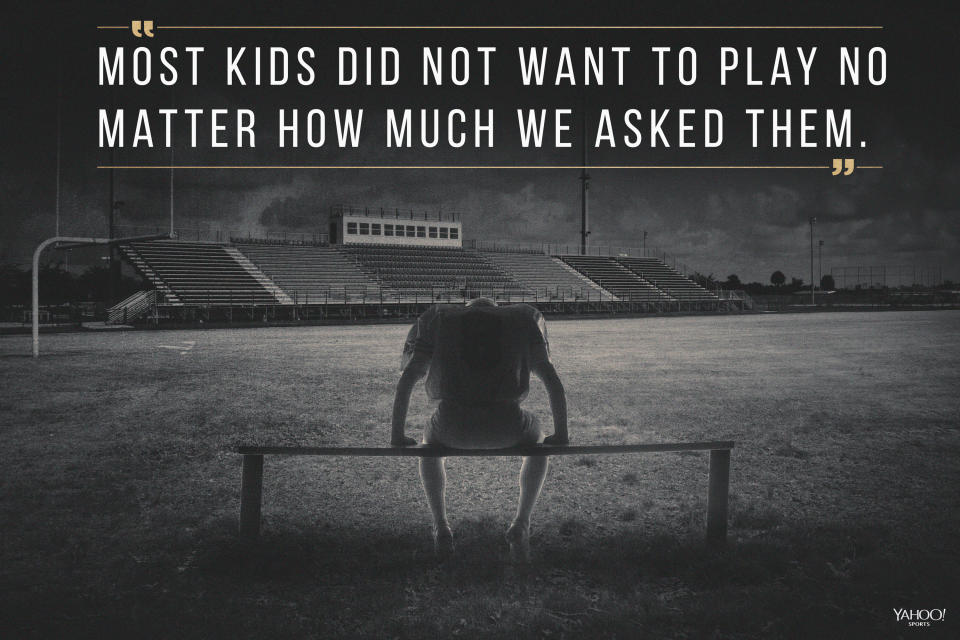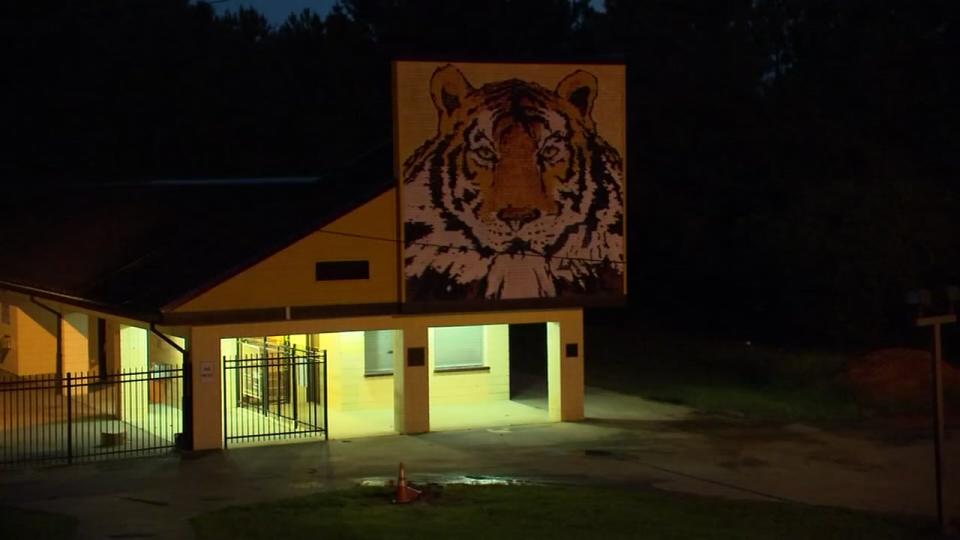Varsity blues: Football participation on the decline across the country

Nervous that he wouldn’t have enough players to feel comfortable fielding a varsity football team this year, the coach of a North Carolina high school responded the way anyone in his profession would under the circumstances.
He started recruiting.
Cedar Ridge High School coach Scott Loosemore began his all-important search for new players last spring by organizing a college-style visit day for the area’s most promising eighth graders and their parents. Members of the Cedar Ridge football team led a campus tour, a highlight video played and then Loosemore took the stage to tout the merits of his program.
When Loosemore wasn’t scouring neighboring middle schools for talent, he would seek out players on his own campus. He attended Cedar Ridge baseball, lacrosse and basketball games to pitch those athletes on going out for football. He did the same with any big, athletic boys he spotted in the hallways, the weight room or while scouting PE classes.
“To be honest, I even asked kids who didn’t look that strong or athletic,” Loosemore admitted. “We recruited on campus nonstop, but it was really difficult. Most kids did not want to play no matter how much we asked them.”
While dwindling turnout is an issue high school football programs across the country are facing, the sport’s participation crisis has struck Cedar Ridge unusually hard. The school went from one win shy of playing for a state championship in North Carolina’s second-largest enrollment division in 2010 to scrambling to find enough healthy players to go 11-on-11 in practice eight years later.
Even after Cedar Ridge surrendered four times as many points as it scored during a dismal 10-loss season last fall, Loosemore recognized the worst was yet to come. The mainstays from that team either graduated, transferred or opted to pursue other sports, leaving the fate of Cedar Ridge’s upcoming football season resting on Loosemore’s desperate recruiting push.
Despite Loosemore’s tireless attempts to replenish his roster, Cedar Ridge entered the summer with roughly 35 players, only 14 of which were juniors and seniors. That’s scarcely enough upperclassmen to field a varsity team at a small school, let alone a 1,100-student one whose league sent players to Oklahoma, Oregon, Vanderbilt, N.C. State and North Carolina the past few years.
Were this a Disney movie, Cedar Ridge’s season would finish with Loosemore and his undermanned, ragtag team hoisting a championship trophy after overcoming insurmountable odds. In reality, the ending won’t be nearly so happy.
In late June, Loosemore and Cedar Ridge administrators decided they couldn’t send a young, overmatched team to slaughter. They announced they would only field a JV football team in 2018 and offered their juniors and seniors the right to transfer to a neighboring school without penalty.
“There were a lot of tears shed the morning we told those kids,” Loosemore said. “It was a safety issue. I just did not think we would make it through the season against the teams we were going to have to play. We would have been playing with 14 year olds against 17 and 18 year olds. They didn’t like it, but they totally understood where I was coming from.”

More high schools struggling to fill varsity football rosters
Cedar Ridge’s struggle to find enough players to field a varsity football team exemplifies the sport’s nationwide participation decline. A growing number of parents are hesitant to allow their kids to play football because of the threat of head injuries or the belief that specializing in another sport year-round is the best path toward landing a college scholarship.
An annual survey released Friday morning by the National Federation of State High School Associations revealed that the number of students playing 11-man football in the United States has declined 6.7 percent since its peak in 2009. The 1,038,179 boys and girls who participated during the 2017-18 school year represent 11-man football’s lowest total since 2004.
At least a dozen high schools across the country have announced this summer that they’re not fielding varsity football teams in 2018, a diverse list that includes former state champions in Indiana and Virginia. Countless other schools have compensated for declining turnout by dropping from 11- to eight-man football or eliminating their freshman or JV teams.
Losing teams predictably tend to be hit hardest by low participation numbers, but even some of the nation’s most successful football factories aren’t immune. Among the programs that dropped JV football in 2017 was Long Beach Poly, the tradition-rich Southern California powerhouse that has produced more NFL draft picks than any other high school in the country.
NFHS executive director Karissa Niehoff attempted to put a positive spin on high school football’s gradual participation decline. She noted that football was still the top participatory sport for boys and that the number of schools sponsoring six- and eight-player football had actually increased slightly from the previous year.
“We are encouraged that the decline in high school football has slowed due, in part, to our efforts in reducing the risk of injury in the sport,” Niehoff said. “While there may be other reasons that students elect not to play football, we have attempted to assure student-athletes and their parents that thanks to the concussion protocols and rules in place in every state in the country, the sport of football is as safe as it ever has been.”
Concern over football-related head injuries indeed isn’t the only reason for the sport’s recent decline in participation, but it’s undoubtedly a contributing factor. The barrage of national media coverage spotlighting the potential link between CTE and football head trauma has been relentless since the degenerative brain disease entered the public consciousness nearly a decade ago.
It started with high-profile ex-NFL stars Junior Seau, Dave Duerson and Andre Waters being diagnosed with CTE after each took their own life. Attention spiked anew after Boston University’s groundbreaking 2015 study found CTE in 87 of 91 deceased NFL players’ brains examined. The release of the Will Smith movie “Concussion” helped take the issue mainstream, as has the flurry of NFL players who have admitted they’re scared to allow their sons to play football.
What frustrates high school football coaches is that their sport has been scapegoated even though athletes in other contact sports are also at risk of repeated head trauma. Neither soccer nor lacrosse players are immune to concussions, yet the NFHS survey shows that participation in both those sports has dramatically increased over the past decade.
Football coaches also note their sport’s risks often receive vastly more media attention than the safety measures implemented to address them. Safer tackling techniques, fewer full-contact practices and improved helmet technology each reduce the amount of head trauma high school football players endure.
“We, as football coaches, have to do a better job of getting the word out that we’re a safe sport,” said Wayne Racine, who will coach the JV football team at Bishop Noll High this season after the Indiana school dropped varsity football for a year due to lack of turnout.
“People talk about us like we’re the boogeyman, but we’re getting a bad rap. We’re blocking smarter, we’re tackling smarter and it’s really a beautiful sport. Football teaches kids more about life than any other sport. Sometimes in life you’re going to get knocked down and you have to get back up. Football teaches mental toughness.”

Safety concerns, specialization fuel participation decline
If Cedar Ridge’s experience this past spring is any indication, it may be harder than Racine thinks to fix football’s image. Loosemore stressed his commitment to player safety in conversations with apprehensive parents, but several still felt football was too dangerous to allow their sons to participate.
It certainly didn’t help Loosemore that a junior varsity linebacker from a neighboring school suffered a serious brain injury last October that left him in a medically induced coma for two weeks. Only after several brain surgeries and weeks of rehab did Orange High School’s Thys Oldenburg return home just before Christmas.
“That really had an effect on a lot of parents,” Loosemore said. “I had two kids who played for me last year, and their parents would not let them come back out because of that.”
Of course, concern about player safety wasn’t the only impediment Loosemore faced last spring as he tried to replenish his roster.
Some kids he approached had AAU basketball or travel baseball commitments during the spring and summer that kept them from coming out for football. Other kids had after-school jobs that conflicted with football practice or simply didn’t want to play for a losing team.
“The coaches were really on top of talking to kids in the hallway and asking them to come out and see how they liked it, but a lot of times it went in one ear and out the other,” Cedar Ridge senior linebacker Thomas Upchurch said. “Kids just didn’t want to play.”
While everyone associated with Cedar Ridge football would have preferred to field a varsity team this year, the outcome isn’t all bad for those involved.
Loosemore resigned in July to accept a teaching position and assistant coaching job at one of the state of North Carolina’s top football schools. A handful of Cedar Ridge juniors and seniors took advantage of the school district’s invitation to transfer and will compete for playing time at Orange High School. The remaining younger players should benefit from the experience of instant playing time and the confidence boost of facing a JV schedule.
If anyone has reason to grumble about Cedar Ridge’s decision to drop varsity football this year, Upchurch is probably the guy. He had a chance to earn college scholarship offers with a strong senior season, but instead he intends to graduate in December and enroll in technical school to learn to become an auto mechanic.
You won’t hear Upchurch complain, though. He insists he would have passed on the chance to play college football even if the opportunity had arisen. His only regret is not ending his football career on his own terms.
“Last year, at the last game of junior year, I didn’t think that was going to be my last game of football,” Upchurch said. “I thought I would have another chance to play, but I didn’t.
“We’re not going to have a senior night, which is the only part that’s a little upsetting. I guess you could say the story ended a little too soon.”
More from Yahoo Sports:
• ESPN anchor has had it with football
• Dan Wetzel: Culture of cover-up helped save Urban Meyer’s job
• Former MSU coach faces charges tied to Nassar investigation
• Ex-NBA ref: Suspension changed my life
– – – – – – –
Jeff Eisenberg is a sports writer for Yahoo Sports. Have a tip? Email him at jeisenb@oath.com or follow him on Twitter!


